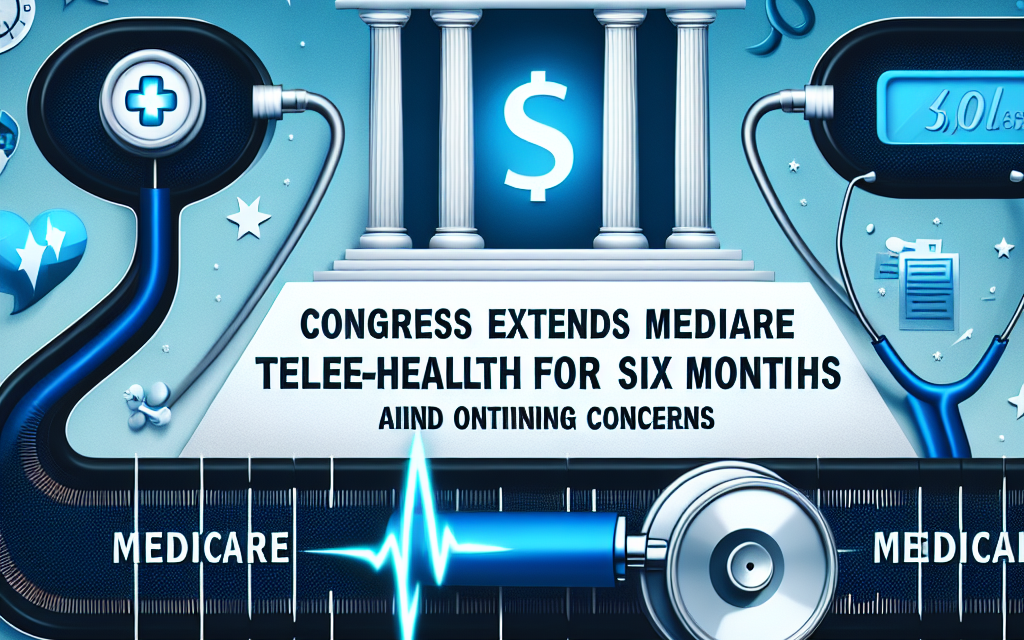Congress Extends Medicare Telehealth for Six Months Amid Ongoing Concerns
The COVID-19 pandemic has dramatically reshaped the landscape of healthcare delivery, with telehealth emerging as a vital service for millions of Americans. In response to the urgent need for accessible healthcare during the pandemic, Congress has extended Medicare telehealth services for an additional six months. This decision has sparked discussions about the future of telehealth, its benefits, challenges, and the implications for both patients and providers. This article delves into the various aspects of this extension, exploring its significance, the ongoing concerns surrounding telehealth, and what it means for the future of healthcare in the United States.
The Rise of Telehealth: A Necessity During the Pandemic
Telehealth has been around for years, but its adoption skyrocketed during the COVID-19 pandemic. With lockdowns and social distancing measures in place, healthcare providers had to pivot quickly to remote care solutions. The Centers for Medicare & Medicaid Services (CMS) expanded telehealth services under Medicare, allowing beneficiaries to access a wide range of services from the comfort of their homes.
According to a report from the Department of Health and Human Services (HHS), telehealth visits increased from approximately 840,000 in 2019 to over 52 million in 2020. This dramatic rise highlights the necessity of telehealth in maintaining continuity of care during a public health crisis.
- Accessibility: Telehealth has made healthcare more accessible, particularly for individuals in rural areas where healthcare facilities may be limited.
- Convenience: Patients can attend appointments without the need for travel, saving time and reducing exposure to illness.
- Continuity of Care: Chronic disease management has been facilitated through telehealth, allowing patients to maintain regular contact with their healthcare providers.
As the pandemic continues to evolve, the extension of Medicare telehealth services is a crucial step in ensuring that patients can continue to receive care without interruption. However, this extension also raises questions about the long-term viability of telehealth and the potential challenges that lie ahead.
Understanding the Extension: What It Means for Medicare Beneficiaries
The recent decision by Congress to extend Medicare telehealth services for six months is a temporary measure that aims to provide stability during an uncertain time. This extension allows beneficiaries to continue accessing a wide range of services, including mental health counseling, primary care visits, and specialist consultations, without the need for in-person visits.
For many Medicare beneficiaries, this extension is a lifeline. According to a survey conducted by the Kaiser Family Foundation, nearly 50% of older adults reported that they had used telehealth services during the pandemic. The extension ensures that these individuals can maintain their healthcare routines without the added stress of navigating in-person visits during a pandemic.
- Continued Access: Beneficiaries can continue to access telehealth services without interruption, ensuring that they receive necessary care.
- Flexibility: The extension allows for greater flexibility in scheduling appointments, accommodating the needs of patients who may have difficulty traveling.
- Cost-Effectiveness: Telehealth can be a more cost-effective option for both patients and providers, reducing overhead costs associated with in-person visits.
However, while the extension provides immediate relief, it is essential to consider the long-term implications for Medicare beneficiaries. The ongoing concerns surrounding telehealth, including reimbursement rates, technology access, and regulatory challenges, must be addressed to ensure that telehealth remains a viable option for all patients.
Challenges and Concerns Surrounding Telehealth
Despite the benefits of telehealth, several challenges and concerns persist. As Congress extends Medicare telehealth services, it is crucial to address these issues to ensure the sustainability of telehealth as a healthcare delivery model.
One of the primary concerns is the issue of reimbursement. While telehealth services have been expanded under Medicare, there is uncertainty about whether these changes will become permanent. Many healthcare providers are concerned about the reimbursement rates for telehealth services, which may not adequately reflect the costs associated with delivering care remotely.
- Reimbursement Rates: Providers may face financial challenges if reimbursement rates for telehealth services are lower than those for in-person visits.
- Technology Access: Not all patients have access to the necessary technology or internet connectivity to participate in telehealth visits, creating disparities in care.
- Regulatory Hurdles: The regulatory landscape surrounding telehealth is complex, with varying state laws and licensing requirements that can hinder providers’ ability to offer services across state lines.
Additionally, there are concerns about the quality of care delivered through telehealth. While many patients have reported positive experiences, there are limitations to remote consultations, particularly for conditions that require physical examinations or diagnostic tests. Providers must navigate these challenges to ensure that patients receive comprehensive care, regardless of the delivery method.
The Future of Telehealth: Opportunities and Innovations
As Congress extends Medicare telehealth services, the future of telehealth presents both opportunities and innovations. The pandemic has accelerated the adoption of telehealth technologies, and many healthcare organizations are exploring new ways to enhance remote care delivery.
One significant opportunity lies in the integration of artificial intelligence (AI) and machine learning into telehealth platforms. These technologies can improve patient triage, enhance diagnostic accuracy, and streamline administrative processes. For example, AI-powered chatbots can assist patients in scheduling appointments, answering common questions, and providing health information.
- AI Integration: AI can enhance telehealth by improving patient engagement and streamlining workflows for healthcare providers.
- Remote Monitoring: Wearable devices and remote monitoring technologies can provide real-time data to healthcare providers, enabling proactive management of chronic conditions.
- Telehealth Expansion: The extension of telehealth services may encourage more providers to adopt telehealth technologies, leading to a broader range of services available to patients.
Moreover, the ongoing discussions about telehealth regulations may lead to more standardized practices across states, making it easier for providers to offer services to patients regardless of their location. This could significantly enhance access to care, particularly for underserved populations.
Case Studies: Successful Telehealth Implementations
To better understand the impact of telehealth, it is essential to examine case studies of successful implementations. Various healthcare organizations have effectively integrated telehealth into their service offerings, demonstrating its potential to improve patient outcomes and enhance care delivery.
One notable example is the Cleveland Clinic, which rapidly expanded its telehealth services during the pandemic. The organization reported a 60% increase in telehealth visits, allowing patients to receive care without risking exposure to COVID-19. The Cleveland Clinic utilized a user-friendly platform that enabled patients to schedule appointments easily and access their healthcare providers from home.
- Cleveland Clinic: The organization successfully transitioned to telehealth, demonstrating the feasibility of remote care delivery during a public health crisis.
- Teladoc Health: This telehealth provider saw a significant increase in demand for virtual visits, highlighting the growing acceptance of telehealth among patients.
- Mayo Clinic: The Mayo Clinic implemented telehealth services for various specialties, ensuring that patients could continue receiving care while minimizing in-person visits.
These case studies illustrate the potential of telehealth to enhance patient care and improve access to services. As more healthcare organizations adopt telehealth technologies, it is essential to learn from these successes and address the challenges that may arise.
Conclusion: The Path Forward for Telehealth
The extension of Medicare telehealth services for six months is a critical step in ensuring that patients continue to receive care during an ongoing public health crisis. While telehealth has proven to be a valuable tool for enhancing access to healthcare, several challenges and concerns must be addressed to ensure its long-term viability.
As we look to the future, it is essential to embrace the opportunities presented by telehealth innovations, including AI integration and remote monitoring technologies. By addressing reimbursement issues, regulatory hurdles, and disparities in technology access, we can create a more equitable healthcare system that leverages the benefits of telehealth for all patients.
In summary, the extension of Medicare telehealth services is a temporary measure that highlights the importance of remote care delivery in today’s healthcare landscape. As we navigate the complexities of telehealth, it is crucial to prioritize patient needs and ensure that all individuals have access to the care they deserve.





